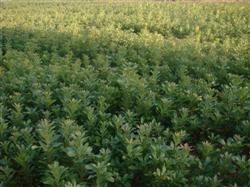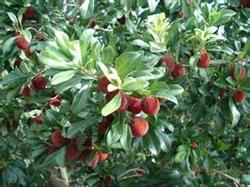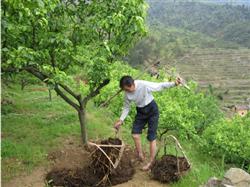Cultivation techniques of Myrica rubra

Biological characteristics of plant cultivation: like warm and humid climate with more clouds. Intolerant to strong light, not cold. Mountain north or east, deep soil layer, loose fertile, good drainage acid yellow soil planting is appropriate. Cultivation techniques: a wide variety of cultivation, according to fruit color can be divided into white, red, pink, black species. The propagation method is seed, rationing and grafting propagation. Seed propagation: selecting ripe fruit, stripping pulp, drying in shade, and storing with wet sand stratification. Spring sowing, after emergence to the second year can be used as seedlings. Plant division propagation; dig out old plant stumps and plant biennial branches. Grafting propagation: selecting two-year-old seedlings as rootstock, grafting or cutting before and after Qingming, transplanting for another 2 years, opening holes according to row spacing of 5m×5m, one plant per hole, covering soil and compacting, watering. About 450 plants were planted per hectare, and a few male plants were planted appropriately for pollination. Field management: loosening soil and weeding once in June and December respectively. Manure and decomposed cake fertilizer are applied in summer, manure and compost are applied in winter, and ditch ring application method can be used. Pest control: pests have bayberry caterpillar, aphid, longicorn, etc.
- Prev

Control techniques of root rot of red bayberry
1. Cultivate the soil. Combine deep turn to carry on a tree plate fertilizer mud to press soil and cultivate soil, can use local material, use mountain topsoil, plant ash, river mud, pond mud and so on, generally every two years, each time can increase about 5 cm, in order to increase the plough layer of bayberry orchard, protect the root system, increase the extension range of root system, improve the root system of red bayberry.
- Next

Fertilizer application rate of red bayberry
Base fertilizer can be used with rotten fence compost, compost or cake fertilizer. Adult fruiting trees apply 25 kg of fence fertilizer or compost or 4 kg of cake fertilizer. Young trees apply 1-2 kg cake fertilizer. The first fruit tree applied 12.5 kg fence fertilizer + 20 kg coke ash. Strong fruit fertilizer: apply 1-3 kg potassium sulfate fertilizer or 25 kg coke ash. Postharvest fertilizer: can plant.
Related
- Moge, come on! The staff of the peasant association in the producing area of cantaloupe were frightened when the crowd gathered.
- Causes and Solutions of low Fruit setting rate of Apple
- Symptoms and control measures of passion fruit virus disease
- Fruit growing lesson: how do apple orchards keep high yields?
- Can you build orchards in the mountains? What are the pros and cons?
- How to manage the coloring period of Crisson grape?
- This paper introduces the processing technology of two kinds of fig products.
- How much is a month for retired teachers in rural areas by 2020?
- How can strawberry planting increase sugar content? We should pay attention to management in many aspects.
- What are the cultivation techniques on how to improve the yield of golden fruit?

